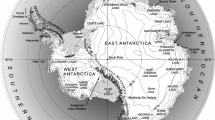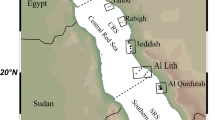Abstract
The occurrence of the unique autotrophic ciliate Mesodinium rubrum was investigated in a suite of lakes of various salinities situated in the Vestfold Hills oasis, Princess Elizabeth Land (eastern Antarctica). M. rubrum was found to occur in all but the most hypersaline lakes in the survey but was most numerous in the more brackish lakes. Salinity and water column temperature appeared to be the most important factors controlling the occurrence and abundance of this species. Nutrient levels (phosphate and nitrate) did not appear to be important controlling factors, although their influence may have been distorted by the fact that nutrient concentrations were generally higher in the more saline lakes. The widespread occurrence of this species in brackish and saline lakes of the Vestfold Hills provides opportunities to study the ecology and possible physiological and ultrastructural adaptations to living in a high-latitude environment of this ubiquitous and important species in marine microbial food webs.
Similar content being viewed by others
References
Adamson DA, Pickard J (1986) Cainozoic history of the Vestfold Hills. In: Pickard J (ed) Antarctic oasis. Academic Press, Sydney, pp 63–97
Choi JW, Stoecker DK (1989) Effects of fixation on cell volume of marine planktonic protozoa. Appl Environ Microbio 55:1761–1765
Crawford DW (1989) Mesodinium rubrum: the phytoplankter that wasn't. Mar Ecol Prog Ser 58:161–174
Crawford DW, Purdie DA (1992) Evidence for avoidance of flushing from an estuary by a planktonic phototrophic ciliate. Mar Ecol Prog Ser 79:259–265
Fenchel T (1968) On “red water” in the Isefjord (inner Danish waters) caused by the ciliate Mesodinium rubrum. Ophelia 5:245–253
Garrison DL, Buck KR (1991) Surface-layer sea-ice assemblages in Antarctic pack ice during the austral spring: primary production and community structure. Mar Ecol Prog Ser 75:161–172
Hand RM, Burton HR (1981) Microbiol ecology of an Antarctic saline meromictic lake. Hydrobiologia 82:363–374
Hansmann E (1973) Pigment analysis. In: Stein JR (ed) Handbook of phycological methods. Culture and growth measurements. Cambridge University Press, Cambridge, pp 359–368
Hibberd DJ (1977) Ultrastructure of the cryptomonad endosymbiont of the red-water ciliate Mesodinium rubrum. J Mar Biol Assoc UK 57:45–61
Laybourn-Parry J, Marchant HJM (1992) The microbiol plankton of freshwater lakes in the Vestfold Hills, Antarctica. Polar Biol 12:405–410
Leakey RJG, Burkill PH, Sleigh MA (1993) Planktonic ciliates in Southampton Water: quantitative taxonomic studies. J Mar Biol Assoc UK 73:579–594
Leakey RJG, Burkill PH, Sleigh MA (1994) A comparison of fixatives for the estimation and biovolume of marine planktonic ciliate populations. J Plankton Res 16:375–389
Lindholm T (1985) Mesodinium rubrum —a unique photosynthetic ciliate. Adv Aquat Microbiol 3:1–48
Lindholm T (1992) Mesodinium rubrum —a photosynthetic ciliate. In: Reisser W (ed) Algae and symbioses. Biopress, Bristol, pp 501–514
Lindholm T, Lindroos P, Mörk A-C (1988) Ultrastructure of the photosynthetic ciliate Mesodinium rubrum. Biosystems 21: 141–149
Mackereth JJH, Heron J, Talling JF (1989) Water analysis. Freshwater Biol Assoc Sci Publ no. 36
Montagnes DJS, Lynn DH (1989) The annual cycle of Mesodinium rubrum in the waters surrounding the Isles of Shoals, Gulf of Maine. J Plankton Res 11:193–201
Müller H, Geller W (1993) Maximum growth rates of aquatic protozoa: the dependence on body size and temperature reconsidered. Arch Hydrobiol 126:315–327
Packard TT, Blasco D, Barber RT (1978) Mesodinium rubrum in the Baja California upwelling system. In: Boje R, Tomczak M (eds) Upwelling ecosystems. Springer, Berlin, Heidelberg New York, pp 73–89
Perriss SJ, Laybourn-Parry J, Marchant HJM (1993) Mesodinium rubrum (Myrionecta rubra) in an Antarctic brackish lake. Arch Hydrobiol 128:57–64
Satoh H, Watanabe K (1991) A red-water bloom caused by the autotrophic ciliate, Mesodinium rubrum, in the austral summer in the fast ice near Syowa Station, Antarctica, with note on their photosynthetic rate. J Tokyo Univ Fish 78:11–17
Stoecker DK, Taniguchi A, Michaels AE (1989) Abundance of autotrophic, mixotrophic and heterotrophic planktonic ciliates in shelf and slope waters. Mar Ecol Prog Ser 50:241–254
Stoecker DK, Putt M, Davis LH, Michaels AE (1991) Photosynthesis in Mesodinium rubrum: species-specific measurements and comparison to community rates. Mar Ecol Prog Ser 73: 245–252
Stoecker DK, Buck KR, Putt M (1992) Changes in the sea-ice brine community during the spring-summer transition, McMurdo Sound, Antarctica. I. Photosynthetic protists. Mar Ecol Prog Ser 84:265–278
Vincent WF (1988) Microbiol ecosystems of Antarctica. Cambridge University Press, Cambridge
Author information
Authors and Affiliations
Rights and permissions
About this article
Cite this article
Perriss, S.J., Laybourn-Parry, J. & Marchant, H.J. Widespread occurrence of populations of the unique autotrophic ciliate Metodinium rubrum (Ciliophora: Haptorida) in brackish and saline lakes of the Vestfold Hills (eastern Antarctica). Polar Biol 15, 423–428 (1995). https://doi.org/10.1007/BF00239719
Received:
Accepted:
Issue Date:
DOI: https://doi.org/10.1007/BF00239719




